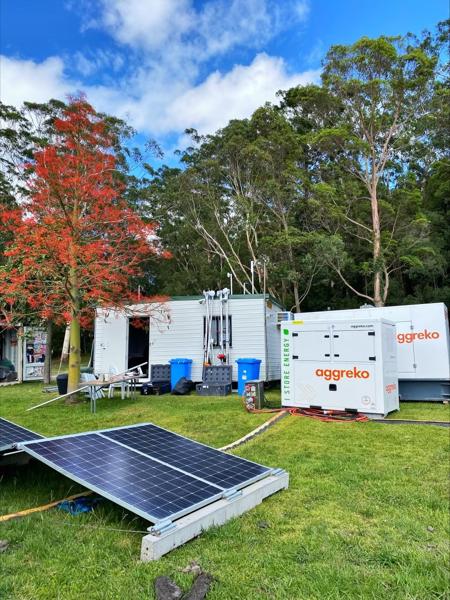Making festival power greener
Environmentally friendly power for a three-day festival halved fuel usage and significantly reduced the event’s carbon footprint.
- The Challenge
Reliable, low emission power for a major festival
- The Solution
Hybrid system using diesel, battery, and solar power
- The Impact
Hugely successful event with significantly reduced fuel use and CO2 emissions
Client:EVENTelec
Location:Byron Bay, NSW, Australia
Sectors:Events
The Challenge
Low emission festival power
EVENTelect provides electrical infrastructure to over 100 major Australian events every year.
The three-day Falls Festival over New Year 2022 featured acts such as Arctic Monkeys, Lil Nas X, and kids’ favourite The Wiggles.
Situated in the North Byron Parklands it needed a unique solution as it has no access to mains power and is spread over a wide area.
The event organisers also wanted to demonstrate their environmental credentials so EVENTelect asked Aggreko to provide all the festival power needed whilst reducing greenhouse gas emissions, the amount of diesel fuel used, and generator noise created.
The three-day Falls Festival over New Year 2022 featured acts such as Arctic Monkeys, Lil Nas X, and kids’ favourite The Wiggles.
Situated in the North Byron Parklands it needed a unique solution as it has no access to mains power and is spread over a wide area.
The event organisers also wanted to demonstrate their environmental credentials so EVENTelect asked Aggreko to provide all the festival power needed whilst reducing greenhouse gas emissions, the amount of diesel fuel used, and generator noise created.

The Solution
Hybrid power combines diesel, battery, and solar
Due to the limitations of the site, Aggreko needed to use multiple smaller generators to provide all the necessary power.
We installed 60 generators ranging from 20kVA to 700kVA to ensure coverage across the site for the 26 days leading up to and during the festival.
Aggreko also installed a hybrid system consisting of a 200kVA diesel generator paired with a 90kVA battery storage unit and a 60 kVA diesel generator paired with a 45kVA battery unit and a 5kW solar array.
We installed 60 generators ranging from 20kVA to 700kVA to ensure coverage across the site for the 26 days leading up to and during the festival.
Aggreko also installed a hybrid system consisting of a 200kVA diesel generator paired with a 90kVA battery storage unit and a 60 kVA diesel generator paired with a 45kVA battery unit and a 5kW solar array.
The Impact
Reliable power, reduced fuel use and emissions
The wide range of generators across the site ensured that power was always available wherever and whenever it was needed.
The hybrid system allowed the festival to significantly reduce its carbon footprint; thanks to the batteries and solar array, the 200kVA generator was running for just 36% of the time and the 60kVA generator was running for just 64% of the time.
This meant only 8,552 litres of diesel was used - less than half compared to if the generators had been running throughout - leading to total CO2 savings of 30.6 tonnes.
The hybrid system allowed the festival to significantly reduce its carbon footprint; thanks to the batteries and solar array, the 200kVA generator was running for just 36% of the time and the 60kVA generator was running for just 64% of the time.
This meant only 8,552 litres of diesel was used - less than half compared to if the generators had been running throughout - leading to total CO2 savings of 30.6 tonnes.
